Wildlife Photolog
-Paul McDougall
Kenya has many beautiful natural wonders. It is teeming with wildlife. It has many National Parks and Reserves including Lake Nakuru National Park, Amboseli National Reserve, Tsavo National Park, Samburu National Resaerve and the most famous Masai Mara National
Reserve.
All of the big 5 are found in Kenya. The big 5 are so named because they were considered the most challenging animals to hunt in colonial times and also the heads of these animals made the most impressive and sought after trophies. The big 5 are Lions, Leopard,
Elephant, Rhino and Buffalo.
The Lion (Panthera leo)
The Lion is the national animal of Kenya, it features on all Kenyan coins and a lion’s head is the watermark on all Kenyan Shilling notes. It is the largest of all African carnivores. The African Lion is larger and more social than its Indian relative. Lions
in Tsavo received fame for being man-eaters. From 1895-1901 when the Mombassa to Kampala railway was being built, all of the rolling stock and labour were imported from India – 2 lions systematically killed 28 indian workers and unknown numbers of local people
when the construction reached the area of Tsvo in 1898, they were eventually killed by the man in charge of the construction Lt . Col J.H. Patterson.
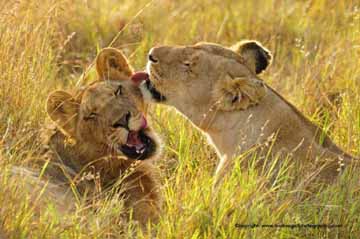
The male lion is larger and generally has a mane (although males found in Amboseli and Tsavo generally do not). Female lions are smaller and are without the distinctive mane, this is a genetic feature as the females do most of the hunting and the mane would
get in the way. Lions live in prides of up to 40 (Masai Mara), pride numbers generally depend on the variety and availability of food. Prides are made up of a base of females with the males being transient and usually having short tenures with a pride, there
are always younger and stronger males looking to take over the pride. When a male or males take over a pride the first thing they will do is kill all of the young cubs, this then means the females will come in to oestrus and be ready to mate again thus ensuring
that the new males genes are present in the pride offspring.
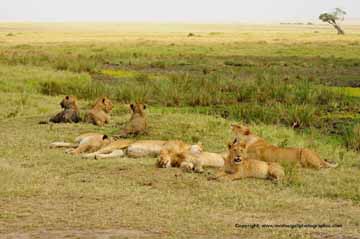
Lions mate for 13 days – the male and female often leave the pride whilst they are mating, they can mate for up to 72 times a day and copulation lasts around 20-30 seconds a time. When the female gives birth she leaves the pride temporarily and will return
to the pride 4- 8 weeks later with her new cubs. Lionesses generally give birth to 3 cubs, but it ranges between 1 and 4. Lions are very social cats and often greet each other by rubbing noses and cheeks; they also have many distinct sounds and roars which
are all important in the communication process. Lions use communication to advertise their presence, locate pride members, strengthen social bonds and to intimidate rivals.
Lions spend up to 18 hours a day resting and sleeping. Lions eat a variety of prey species and are known to scavenge a meal sooner than hunt for one. When lions do hunt they hunt in groups with the females doing most of the hunting, they generally will hunt
an animal big enough to feed the whole pride with zebra, wildebeest and even buffalo being favourite prey species. Lions can still be seen in large numbers in Kenya, all of the larger national parks and reserves will have them. Lions are however facing the
same struggles as many other big cats and the number of lions in Kenya is dropping due to habitat destruction and encroachment by humans. The best place in Kenya to see these beautiful big cats is Masai Mara National Reserve, especially between July and October
when the great wildebeest and zebra migration enters the reserve.
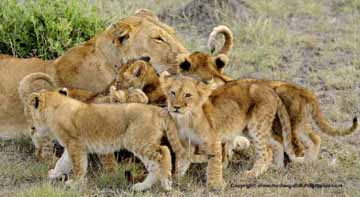
I have had so many amazing moments photographing lions, I really cannot choose a favorite one, there have been so many for so many reasons. Maybe it would be the big male lion roaring on a cold evening in Masasi Mara , and listening to this deafening noise
and seeing the breath come from its mouth. Maybe it would be the 3 lionesses with the 11 young cubs walking right past our vehicle full of confidence and purpose, Probably my best lion moment though was in Botswana, I was staying at a luxury bush camp and
helping out there for a couple of weeks, one night I spent in the guesthouse and was visited by a huge pride of lions, they had come to drink from the pool of water right outside my downstairs bedroom window. I leant on the window sill and watched them drinking
through the mesh window, when all of a sudden one of the lionesses put her paws on the window ledge and looked right at me, I didn’t move for what felt like ages – just looking at her and having her look at me. I could feel her warm smelly breath on my face.
I think that moment was what started my love and fascination with lions.
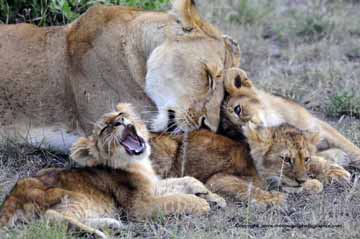
Masai Mara will always be my favorite place for Lions, but one pride in particular became my pride, they were actually called Pauls pride by our company, the reason being was that I had photographed them for over 5 years, young cubs, several sub-adult cubs,
the 3 impressive females who were very successful hunters and the big male who had held his territory for a long time. The pride became my favorite and I spent many hours sat with them photographing and watching them. I was compiling a photo journal of this
pride and the idea was that they would form the basis on a book that I would write about Masai Mara. Unfortunately in April 2009 the whole pride was killed, they had apparently been killing Masai cattle who had been brought in to the park to graze during a
period of severe drought, allegedly they fed on a poisoned cow carcass, the whole pride wiped out on one sad day. When I heard the news it really was like loosing a good friend, not to mention 5 years of photography that at the time I felt had been wasted.
I visited my old prides territory not long ago and there is now a new pride in that area, so now I plan to document this pride, and hopefully still tell their story in a book.
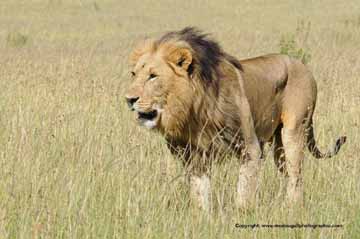
Want to know more about Kenya?
Read
http://wanderwithjo.com/to-kenya-with-love/
|